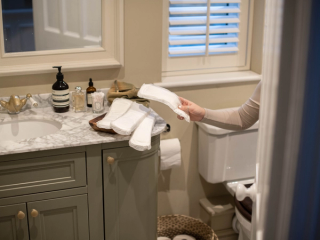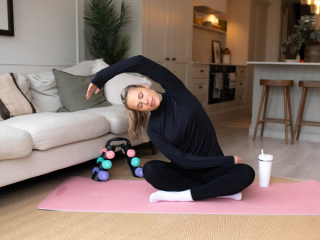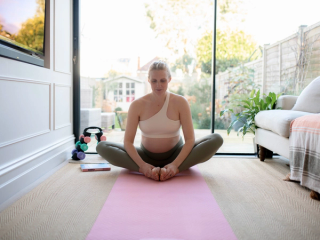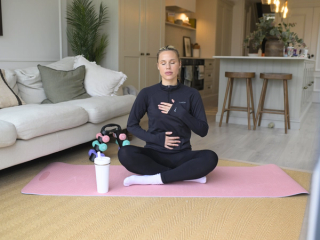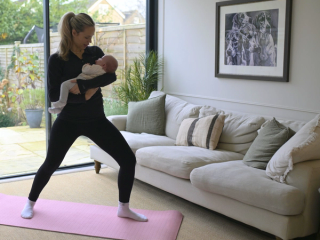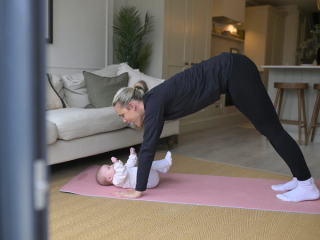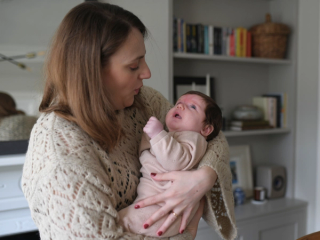
- Home
- Advice Hub
- Newborn
- Postnatal Care
- The Truth About Diastasis Recti
The truth about diastasis recti
Aby, pelvic health specialist, shares all you need to know about the tummy gap (aka diastasis recti). As well as some simple exercises to help build up strength in your abdominal muscles after giving birth.
The medical term is Diastasis Recti Abdominus – a very fancy way of saying separation of the abdominal wall. That all sounds alarming, and many women have an image of the abdominal muscles ripped apart. To understand why this isn’t the case we must first look at what happens to the abdominis muscles in pregnancy.
Every pregnant women by 36 weeks will have a tummy gap. The gap is created by a stretching and thinning of all the abdominal muscles which pulls the two sides further apart; nothing has physically separated. Our abdominal wall is made up of a variety of muscles and connective tissue that are designed to do this to create space for the baby.
After we give birth and that extra slack is no longer needed, we initially have a very soft and jiggly belly. It’s like taking a scrunchie out after you’ve been wearing it for 9 months, it’s not going to have that lovely elasticated spring it did fresh out of the packet. All your muscles and connective tissue are lax after birth. Now the lovely thing is that we have bodies that actively heal – unlike the scrunchie – and so, inside, our healing system is busy drawing those two sides back together. For the majority of women, the gap has come back down to a normal range by 12 weeks postpartum, for some it hasn’t and the body needs some extra guidance.
This is just one small part of the picture though. It’s all very well getting rid of the gap, but we still need the whole abdominal wall to get its spring and strength back. A big contributing factor to ‘mum tum’ is remaining abdominal laxity. The great news is that we can regain that with gradual loading exercises.
Diastasis recovery is all about learning how to manage pressure well, and exercise is the gold standard treatment. All movement creates fluctuations in abdominal pressure. Let’s take the sit-up exercise for example. As we move, the pressure in our tummy is high.
To manage that increase of pressure we need our pelvic floor and abdominal wall to contract to give us the support. If we can’t manage that pressure we are at risk of straining, which you will see in your abdominals with a hard tummy pushing outwards. Once or twice this won’t be an issue, but if we continually strain the abdominal wall then we are at risk of injuring the area and potentially worsening the diastasis. But if we do nothing or keep it too easy then the muscles won’t get stronger and get their spring back. This is why it’s important to gradually build the intensity, and getting help from a specialist would be advised if you have concerns about diastasis.
Here are three simple exercises to get you going to start reconnecting to your abdominal muscles…
- Diaphragmatic breathing – place one hand on your rib cage and one hand on your chest. Now focus on taking deep breaths pushing your ribs out wide and minimising chest movement. Try not to force the breath into your belly, the inhale should all be at the ribs with a softening belly.
- Belly pump – inhale to your ribs to prepare. Exhale, lift your pelvic floor and wrap your tummy in like you’re zipping up a hoodie. Inhale and unzip the hoodie and relax the pelvic floor. The key is that we aren’t bending in our back, the only thing to move is our tummy.
- Wall press up – place both hands on a wall outstretched at shoulder height. Inhale and bring your chest towards the wall, exhale to push away from the wall trying to do a belly pump at the same time. It’s all about coordinating movement with pelvic floor and abdominal control.
These are just a starting point, but hopefully give you an idea of how you can get started with your journey. If you need any further help then get in touch.
Instagram: @thestrongmamaphysio
Email: info@thestrongmamaphysio.com
Website: www.thestrongmamaphysio.com/
Advice & tips

Want to read more? Join the HiPP BabyClub for full access to this article.
As a BabyClub member, you'll get access to a range of exclusive benefits, including:
Monthly competitions
Discounts from our Partners
Expert advice tailored to your little one's age
Weaning recipes
HiPP shop discounts*
*10% off HiPP's online shop does not apply to our First Infant, Anti-Reflux or Comfort Formula Milk.
Important notice: Breastfeeding is best. Follow on milk should only be used as part of a mixed diet from 6 months. Talk to a healthcare professional.





